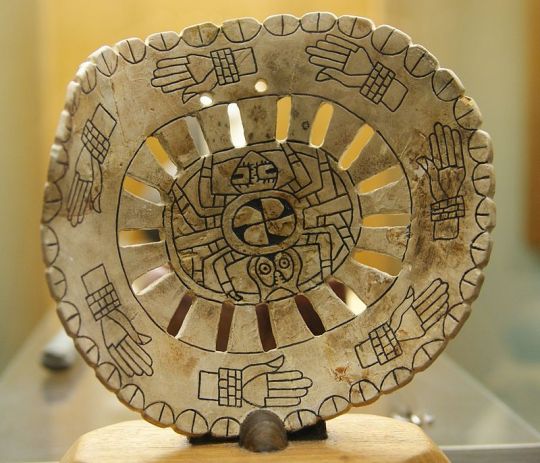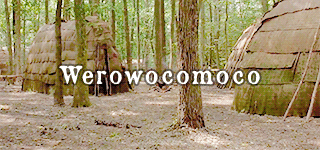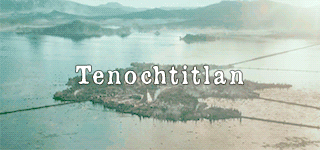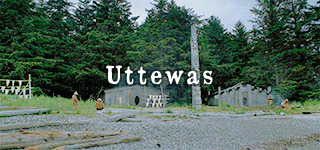#mississippian culture
Text

Engraved shell gorget or pendent uncovered from the Spiro Mounds archeaological site in eastern Oklahoma, Cadoan Mississippian cultue, 800-1500 AD
Housed at the Woolaroc Musuem
699 notes
·
View notes
Text
So Echo is already notable for its connection to the Choctaw Nation, but something that really struck me is that this is probably the first time the Mississippian Mound Builders have been depicted in a mainstream non-documentary film/series.
I really hope this kicks off interest in that civilization and its cities such as Cahokia, Moundsville (which was probably the location in the show), Etowah, and Spiro. Not to mention other civilizations like the Hopewell and Adena.
34 notes
·
View notes
Text

Piasa Dragon
Piasa Dragon likes walks in the forest, swims in the river, limestone caves, and philosophical discussions.
Piasa Dragon dislikes judgy people, bullies, and most "cides," especially pesticides and genocides.
The Piasa is considered a beast from Native American mythology and described as winged with talons, antlers, a human face with long fangs, a beard, and a tail long enough to wrap around it's body ending in a fish tail.
Joliet Marquette is the first European to record the Piasa from seeing a large indigenous painting of it on the limestone bluffs above the Mississippi north of what was the indigenous city of Cahokia near what is now Alton, Illinois.
The Piasa recently came out of hiding after hundreds of years to "set the record straight."
The Piasa scoffed at an 1836 paper by Professor John Russell. In the report Russell wrote that "Piasa" is a Illini word that means "Bird That Devours Men." And that the Piasa was said to have developed a taste for human flesh after eating the dead on a battlefield. "Russell wasn't even there!" the Piasa growled.
"I mean, I thought I was doing the humans a favor by disposing of their dead. There were a lot of them and I didn't want them to stink up the place. You'd think you'd be more concerned with how they died than what happened to them after." The Piasa says it does not prefer to eat humans but will if provoked.
It added that the word "Piasa" is actually an affectionate term of the Illini that can be loosely translated to mean "wise weirdo." "Another thing," the Piasa griped, "Do I look like a bird? No! I'm a dragon. And don't mix me up with my cousin, Mishipeshu, who you've called a 'water panther.' We're very different and, frankly, we're both tired of the comparison. Just don't believe everything you read on Wikipedia"
When asked why it's never revealed itself to Europeans before it replied, "I meant to get around to it but you all were busy with genociding and it seemed you weren't very open to differences. Then your whole Civil War happened and I just thought I'd lay low again until you wiped each other out. That hasn't happen yet and, I don't know... I'm just so tired of the BS."

#piasa#piasa bird#piasa dragon#native american#mythology#Mississippian culture#Mishipeshu#water panther
0 notes
Note
Which legendary Cryptids are appropriated from Indigenous Alaskan/American/Canadian/ cultures?
Honestly, most of them.
Wend!g0: appropriated from Algonquian cultures. The word itself (at least this version that I've censored) is Ojibwe & is an evil cannibal spirit
Sk*nwalkers: Navajo. Evil medicine men
Ravenmockers: Cherokee, called the Kâ'lanû Ahkyeli'skï in the Native language
Deer Woman: various cultures, including Ojibwe, Cherokee, Seminole, Oceti Sakowin, Haudenosaunee, & more.
Bigfoot/Sasquatch/various other giant hairy humanoids: various cultures, especially the Pacific Northwest. My culture also has them, & they're called Mistapew in our language. The word & "cryptid" Sasquatch is a bastardization of the word (& spirit) se'sxa from a Salish language (might be Nlaka'pamuctsin).
Lake Eerie Monster/Ogopogo/various other lake monsters: based on Algonquian horned serpent spirit & other similar spirits. Ogopogo in particular was stolen from the Secwepemc spirit Naitaka & the Sylix spirit nx̌ax̌aitkʷ
Thunderbirds: frequently found in many cultures, but most popular in Pacific Northwest Coast cultures, as evident in their art. Also found in some Algonquian cultures, including mine, & my Cree name has this word in it. This one was just straight up stolen & had a "cryptid" label slapped onto it
Caddy/Cadborosaurus: found in various PNWC cultures, called the hiyitl'iik by the Manhousat people, t'chain-ko by the Sechelt, & numkse lee kwala by the Comox in Vancouver.
Skunk Ape: bastardization of the Seminole Esti Capcaki, fitting the same description.
Shunka Warak’in: based on the name, it sounds like it was stolen from Oceti Sakowin legends, since "Shunka" (šúŋka) means "dog", particularly in Lakota
Adlet: stolen from Inuit legends
Thetis Lake Monster/Canadian Lizard Man: very likely based on & stolen from Haida Gwaii legends
Michigan Dogman: might be a mixture of Odawa legends as well as overlap with wend!g0
Owyhee Mountain Dwarves: stolen from Shoshone and Bannock legends
Nain Rouge: bastardization mix between French folklore called the lutin, and Native legends local to the area
Wampus Cat/Wampus: appears in multiple cultures, including Cherokee.
La Llorona: this one may have been influenced by a "weeping woman" figure that is seen in a few central american cultures, like Cihuacōātl, who has a really similar story with her son Mixcoatl.
Piasa Bird: spirit from Mississippian culture, often depicted in murals and art, including at Cahokia
Pukwudgie: from Wampanoag legends, & is a Wampanoag word. I think similar spirits exist elsewhere
A cryptid is an animal or creature that may or may not biologically exist but has a lot of tall tales surrounding it, and so people into "cryptids" (specifically ones that are appropriated) will use Native legends to fuel their argument & use as "proof" that these "animals" exist/existed, rather than the other way around that these are actually Native spirits that White people got a hold of, decontextualized, bastardized, and then spread inaccurately as "cryptids" or simply "folklore", with the latter being correct. Or people who think that these are just fun stories think "here's a cryptid and oh hey here's a Native spirit fitting the exact same description and the area the cryptid originates from is in the traditional territory as the Native culture this Native spirit is from. It's just a coincidence." & don't think it's because of appropriation at all.
I'm very likely missing some so there's probably more, but I also wouldn't be surprised if multiple OTHER "cryptids" have their origins in Native spirits that we haven't investigated yet. I've also been seeing White people talk about "cryptids" and then just straight up listing Native spirits, even ones that aren't widely known and don't even have a history of being called "cryptids". Which is fucking racist.
Native spirits aren't cryptids.
5K notes
·
View notes
Text

Mask - Gorget
1000 AD - 1500 AD / Tennessee, United States (late Mississippian culture)
Carved shell
Cincinnati Art Museum
82 notes
·
View notes
Text

Mab’s Drawlloween Day 10: Pumpkin
Meet the Ozark wild gourd (curcurbita pepo var. ozarkana) aka “johnny gourd”. It’s vines, leaves, and orange flowers look like most squash plants, but its bitter poisonous squash look like white chicken eggs and are around the same size. I call them ghost eggs, but your state may have its own folk names for it as well as yellow or green varieties of it. The squash may be inedible, but the seeds are edible, plentiful, and high in protein. Before the 1980s it was thought to be a garden escapee, but then researchers noticed it happily growing wild along many rivers in the eastern US states and decided to study it. When they did, they realized it wasn’t like any other squash and was in fact the wild ancestor of potentially all edible and ornamental squash in North America.
This was a big deal because it changed agricultural history. All squash and pumpkins were previously thought to originate in Mexico 8,000 years ago and agriculture and plant cultivation by indigenous peoples wasn’t thought to have happened in the US at all. Seeds of the wild Ozark squash have since been found at multiple excavations sites in the US dating back to 7,000 years and more seeds showing signs of cultivation and early agriculture date back to 3,000 to 4,000 years —predating the Mississippian culture. Archaeologists have provided ample irrefutable evidence against the longstanding racist views of the Native peoples of the United States thanks to this unassuming wild squash.
“The fourth-known prehistoric plant to have been domesticated in North America and is important new evidence that eastern North America was one of the world’s independent centers of plant domestication and agricultural development.”
Source: Barrat, John. “United States Finally May Have a Vegetable It Can Call Its Own : Food: Archeologists have discovered a small, wild gourd that they believe is the ancestor of today’s summer squashes.” Los Angeles Times, November, 1992.
#bane folk#wild ozark squash#curcurbita pepo var ozarkana#poisonous plants#poison path#inktober#mabsdrawlloweenclub#mabsdrawlloween2023#mdwc23#mdwc23d10
23 notes
·
View notes
Text

Pottery with collared rims, where the rim has been thickened to look as if a collar runs around it, is uncommon at Late Woodland sites in the La Crosse area. These three grit-tempered sherds from the Sand Lake Archaeological District near Onalaska have thickened rims that do not quite appear to be full collars, so the excavators called them “pseudo collared.” The pseudo collaring suggested that people in the area may have been experimenting with collaring techniques more common among groups in southeastern Wisconsin, north-central Illinois, and to a limited extent elsewhere in southwest Wisconsin.
For more information:
Boszhardt, Robert F.
2004 The Late Woodland and Middle Mississippian Component at the Iva Site (47Lc42), La Crosse County, Wisconsin, In the Driftless Area of the Upper Mississippi River Valley. The Minnesota Archaeologist 63:60–85.
Finney, Fred, and James Stoltman
1991 The Fred Edwards Site: A Case of Stirling Phase Culture Contact in Southwestern Wisconsin. In New Perspectives on Cahokia: Views from the Periphery, edited by James B. Stoltman, pp. 229–252. Monographs in World Archaeology No. 2. Prehistory Press, Madison, Wisconsin.
Kelly, John M.
2003 Delineating the Spatial and Temporal Boundaries of Late Woodland Collared Wares from Wisconsin and Illinois. Master’s thesis, University of Wisconsin- Milwaukee. https://www.academia.edu/460476/Delineating_the_spatial_and_temporal_boundaries_of_Late_Woodland_collared_wares_from_Wisconsin_and_Illinois
17 notes
·
View notes
Text

The "Spiro Lace", a charred fragment of finely woven cloth found in Craig Mound in the Spiro Mounds Archaeological Site, Oklahoma, United States. Dated circa 1250-1450 CE.
Analysis of textiles found at Spiro reveals that the principal plant fibers used in textile manufacture were canebrake, paw paw, milkweed, and beargrass. Milkweed was likely the plant chosen for making intricate fabrics like this lace textile. Milkweed fibers are not very coarse, and so they are better suited to forming fine threads and cords. Scholars have determined that people at Spiro would cover the surface of the plant fibers with animal furs or feathers to make their textiles softer.
Between 1933 and 1935, Craig Mound was excavated by a commercial enterprise that had bought the rights from local landowners to excavate and to keep or sell the artifacts they recovered. Tunneling into the mound and breaking through the Great Mortuary's log wall, they found many human burials, together with their associated grave goods. They discarded the human remains and the fragile artifacts—made of textile, basketry, and even feathers—that were preserved in these extremely unusual conditions.
Similar fabrics have been uncovered in burials at a Mississippian site in Etowah, Georgia, and the manufacture of this textile style at Spiro could indicate its broader cultural ties.
104 notes
·
View notes
Text




Gradation day for my boy. We are so proud of him and excited about the next part of his life.
My mom, stepmom and I went to Aztalan afterwards, exploring the Mississippian culture in Wisconsin.
30 notes
·
View notes
Note
Would you be willing to talk about the inspiration for you sinti, shunti, kanunuk, & nunni designs? They're really cool!
absolutely !!! :D i usually have pretty explicit stuff that im referencing or am inspired by so im always happy to share <3
*ramble incoming*

[the dr pepper cans are how you know im a real southern usa babe. earlier today there was 5 empty cans in a row until i put them in the recycle bin]
i take a Lot out of the book "sun circles and human hands: the southeastern indians - art and industry" (2001 edition, not the 1957 one) which i have a physical copy of and i have sticky notes tabbing out out and also annotated highlighting every mention of the chickasaw and of sites where i know the chickasaw [or our ancestors, like the chicaza and other early mississippian/SE ntv cultures] so i can reference stuff i know would be from us, but i also take inspiration from all the designs in it because we were all a part of an interconnected cultural network of art
if you are from a tribe that would be from mississippian culture or the southeastern ceremonial complex/southeastern cult as it used to be called, or you know your people wouldve come from places within that like spiro or moundville, and you want to bring more native styling into your art this is THEEE book i would recommend. it is insanely useful. i cant vouch 100% for the text of it, and the second half is mostly kinda grainy b&w scanned photos of pottery and other items lmao, but the first half has lineart depictions OF designs found, with the attribution for the site they were found at. it is a Massive wealth of symbols and style and has been the best thing for wanting to study and emulate SE ndn art. for real i lent a copy to my grandma and then couldnt find where it was and i had to just order a new copy bc i use it so damn much
like i would post pages of it, and before i bought it i survived off the pinterest pics of scanned pages, but i cannot say enough just buy the book and look through it bc its just perfect its so useful. just posting a few pages doesnt do any justice to the wealth of style and art in it. ive tried to make myself some mock style/symbol guides from it, but even those fail to capture the variety of stuff in there and its why i still have it on hand for reference bc every time i get stumped theres so many ideas in there
but ok . book rec rant over (partly.)
i had done sinti homma, the red snake earlier, and i wanted to do a little motley of other simple transparent animals to go with it. so i did! ive got a few different animals that i played with doing, but a lot of them ended up veering too much off of the more hardline ntv style i wanted to do, and the others didnt fit the guideline i had made - i wanted them all to have a pointed tail that pointed to some corner of the frame, and curl around in the square a bit to have more of a sense of motion. i was thinking deer, turtle, spider... but none of those really fit that. so i flipped thru SC&HH for some ideas and came up with some :3



the bottom left one on the first pic there gave me a good idea of what to do with a rat tail, and on the bottom right of that same pic is the Fattest fucking fish and i lifted a lot of that design to use for my fish (and while we're here, the rattler tails on the top right of that pic were what i used for sinti hommas tail), and the bottom left on the second pic gave me the idea for the lizards legs/feet shape, and then i used the chickasaw vocab flashcards of animals to think of animal ideas and so i used the pinti from there to jump me off into doing a rat
theyre all named after the chickasaw words - sinti (snake), shunti (rat/rodent), kanunuk (lizard, specifically green striped lizard, which is why i made it green with stripes lol), nunni (fish) . i use the chickasaw dictionary webpage a lot these days though i should use my dictionary copies more bc they use the spelling style i dont prefer lol
i also want to do maybe a sort of pop art style big print of them, like repeated with different colors behind them? and/or them in a medicine wheel? but those are still wip so we shall see!
#anompolili#TY FOR ASKING ........... i feel so like. patronized. but i never get to talk abt this except into the void so i will seize the chance T_T#hatuk upi homma
9 notes
·
View notes
Text

Copper plate known as the "Etowah Dancer", uncoverd at the Etowah mounds in near Cartersville, Georgia but believed to be crafted in Cahokia, a large Mississippian culture city located in what is now southern Illinois. Dated to the 13th century AD.
from The Smithsonian
550 notes
·
View notes
Text
Choctaw Tribe
The Choctaw were first noted by Europeans in French written records of 1675. Their mother mound is Nanih Waiya, a great earthwork platform mound located in central-east Mississippi. Early Spanish explorers of the mid-16th century in the Southeast encountered ancestral Mississippian culture villages and chiefs.
The Choctaw coalesced as a people in the 17th century and developed at least three distinct political and geographical divisions: eastern, western, and southern. These different groups sometimes created distinct, independent alliances with nearby European powers. These included the French, based on the Gulf Coast and in Louisiana; the English of the Southeast, and the Spanish of Florida and Louisiana during the colonial era.
Most Choctaw allied with the Americans during American Revolution, War of 1812, and the Red Stick War, most notably at the Battle of New Orleans. European Americans considered the Choctaw to be one of the "Five Civilized Tribes" of the Southeast. The Choctaw and the United States agreed to a total of nine treaties. By the last three, the US gained vast land cessions in the Southeast. As part of Indian Removal, despite not having waged war against the United States, the majority of Choctaw were forcibly relocated to Indian Territory from 1831 to 1833. The Choctaw government in Indian Territory had three districts, each with its own chief, who together with the town chiefs sat on their National Council.
Those Choctaw who chose to stay in the state of Mississippi were considered state and U.S. citizens; they were one of the first major non-European ethnic groups to be granted citizenship. Article 14 in the 1830 treaty with the Choctaw stated Choctaws may wish to become citizens of the United States under the 14th Article of the Treaty of Dancing Rabbit Creek on all of the combined lands which were consolidated under Article I from all previous treaties between the United States and the Choctaw.
During the American Civil War, the Choctaw in both Indian Territory and Mississippi mostly sided with the Confederate States of America. Under the late 19th-century Dawes Act and Curtis Acts, the US federal government broke up tribal land holdings and dissolved tribal governments in Indian Territory in order to extinguish Indian land claims before admission of Oklahoma as a state in 1907. From that period, for several decades the US Bureau of Indian Affairs appointed chiefs of the Choctaw and other tribes in the former Indian Territory.
During World War I, Choctaw soldiers served in the US military as some of the first Native American codetalkers, using the Choctaw language. Since the Indian Reorganization Act of 1934, the Choctaw people in three areas have reconstituted their governments and gained federal recognition. The largest are the Choctaw Nation in Oklahoma.
Since the 20th century, the Mississippi Band of Choctaw Indians were federally recognized in 1945, the Choctaw Nation of Oklahoma in 1971, and the Jena Band of Choctaw Indians in 1995

24 notes
·
View notes
Text
JACKSON, Miss. (AP) — When John Tierre launched his restaurant in Jackson’s neglected Farish Street Historic District, he was drawn by the neighborhood’s past as an economically independent cultural hub for Black Mississippians, and the prospect of helping usher in an era of renewed prosperity.
This week he sat on the empty, sun-drenched patio of Johnny T’s Bistro and Blues and lamented all the business he has lost as tainted water flows through his pipes — just like other users in the majority Black city of 150,000, if they were lucky enough to have any pressure at all. The revival he and others envisioned seems very much in doubt.
“The numbers are very low for lunch,” Tierre told The Associated Press. “They’re probably taking their business to the outskirts where they don’t have water woes.”
Torrential rains and flooding of the Pearl River in late August exacerbated problems at one of Jackson’s two treatment plants, leading to a drop in pressure throughout the city, where residents were already under a boil-water order due to poor quality.
60 notes
·
View notes
Photo








Pre-colonial Native American cities/settlements/meeting sites.
Sivan Vahki: just north of Casa Grande, Arizona, Sivan Vahki or Siwañ Waʼa Ki: was a large farming and trade network site of the Sonoran Desert people starting in the early 13th century.
Werowocomoco: With habitation beginning from the 13th century, Werowocomo was a village that later served as the headquarters of the werowance Wahunsenacah, Paramount Chief of the Powhatan confederacy.
Cahokia: Mississippian culture city dating from circa 1050–1350 CE, containing elaborately planned community, woodhenge, mounds, and burials.
Tenochtitlan: built atop a lake, Tenochtitlan was an Aztec altepetl, and was the largest city in the pre-columbian Americas at its peak. It is considered one of the most impressive cities in North America, and is today known as Mexico city.
Tikal: one of the most powerful ancient kingdoms of the Maya, and dates back as far as the 4th century BC, and may have had a population of up to 90,000.
Omahkoyis: Meeting place and trading and cultural hub for the Blackfoot, and later other tribes as well as settlers. The Blackfoot and their ancestors had inhabited the area as early as 12,000 BC, and would later also be known by other names. Colonizing efforts turned the area into a settlement, known today as the city of Edmonton.
Qusqu: also known as “Cuzco”, the city served as the capital for the Inca Empire from the 13th century up into the 16th century upon colonization. However, evidence shows that The Killke people occupied the region from 900 to 1200 CE, prior to the arrival of the Inca, and had constructed a fortress about 1100 CE.
Uttewas: later known as “Old Masset”, was one of the largest Haida villages on Haida Gwaii, and is home to a number of important cultural artifacts, such as numerous totem poles. Today its land is legally designated as Masset Indian Reserve No. 1.
#historyedit#Native American history#canadian history#american history#mexican history#peruvian history#cahokia#tenochtitlan#tikal#maya#aztec#nahua#history#justin's edits#ndn#native american
931 notes
·
View notes
Note
Aside from what you already have given, what are some precolumbian (especially native) archeological sites in Canada that you feel deserves some recognition in a similar way to those of the US such as Mississippian (such as Cahokia & Poverty Point) & southwestern US (such as Puebloan & Anasazi ones)?
You should probably be asking an Indigenous person about this. I don't think my opinion matters that much and I'm far from an expert on this topic.
My Indigenous followers probably have a better idea than me on why these sites are important culturally to them than me, who has no direct relationship to them.
24 notes
·
View notes
Text
Chicago's Fascinating History of Change

Chicago is one of America's largest cities, having grown from a small village of Native Americans to the bustling metropolis it is today. Its fascinating history takeout can be traced through both its cultural roots and developing infrastructure over the last 2 centuries.

Chicago's History of Change. Photo by Victor Lozano. Unsplash.
Chicago's History in Rich Explorers
The City of Chicago, with its extensive and rich history, has witnessed significant transformations. As one of the largest cities in the United States, it has evolved from its founding by French explorers to becoming an industrial powerhouse. Chicago has navigated through numerous eras, leaving an indelible mark on America. Established in 1779 as Fort Dearborn by Jean Baptiste Point du Sable, a fur trader of Haitian and African descent and considered Chicago's first permanent resident, the city's historical tapestry is woven with diverse threads.

Chicago's History of Change. Photo by Victor Lozano. Unsplash.
Early Settlements: Native American Tribes
The history of the United States is intrinsically linked to that of Native American tribes, who first settled in North America thousands of years ago. Tribes like the Apache, Cherokee, and Sioux were among the earliest people to inhabit the continent long before Europeans began exploring.
These tribes lived a nomadic lifestyle for much of this time, forming small settlements as they followed migrating animal herds or sought out lands with more fertile soils.
As these settlements evolved, becoming more extensive and intricate, they developed distinct cultural identities. Notable examples include the Iroquois Confederacy, an alliance of five Native American nations, and the Mississippian Mound Builders, who constructed expansive earthworks in present-day Louisiana and Mississippi.

19th Century Boomtown. Photo byBernd Dittrich. Unsplash.
19th Century Boomtown: Immigration and Development
The 19th century brought an influx of immigrants to the United States, particularly in cities like Chicago. Many immigrants were drawn to this bustling city by its promise of opportunity and potential for personal growth. This time marked a significant boomtown as new businesses, industries, and infrastructure began to develop remarkably.
As these immigrants settled into their new city, they quickly made their mark by introducing fresh ideas and innovations that led to further economic growth. By the end of the 19th century, Chicago had become a major industrial center with an international economy rivaling other large cities worldwide.

20th Centuries. Photo by Geoffrey Hubbs. Flickr.
Manufacturing and Migration: 19th and 20th Centuries
The 19th and 20th centuries marked a period of massive industrialization, and increased demand for manufacturing labor came with it. By 1900, in Chicago's metropolitan area factories. Many of these employees had come from Germany, Ireland, Italy, and other parts of Europe to work in the factories due to limited job prospects back home. This need drove many people to migrate from rural areas to large cities such as Chicago in search of employment opportunities.
Chicago was once known for its large stockyards that processed livestock meat, but the city also grew into one of the most important centers for manufacturing in the United States. Immigrants were critical in fueling Chicago's remarkable growth during this time. They brought new skills and ideas that helped propel the city into a major center for innovation and industry.

Chicago Fire of 1871. Photo by Meridith112. Flickr.
The Great Chicago Fire of 1871
The Great Chicago Fire of 1871 remains one of the most catastrophic disasters in U.S. history. Sparking on October 8th, a small fire broke out on the Southwest Side of Chicago, swiftly engulfing the city. The inferno raged for two days, consuming over three square miles of land and devastating an estimated 17,500 buildings.
The cause of the fire is unknown to this day, though many theories exist as to what may have sparked it. Some believe that a cow belonging to Mrs. O'Leary kicked over a kerosene lamp in her barn, while others suspect that faulty wiring or arson was responsible for starting the blaze.
Whatever its cause, conditions were ripe for disaster due to an arid summer that left much of Chicago covered in sawdust and dried lumber - perfect fuel for any spark that might be ignited.

Post-Fire Rebuilds. Photo by Randy von Liski. Flickr.
Growth Despite Adversity: Post-Fire Rebuilds
The City of Chicago is no stranger to adversity, and the aftermath of the Great Chicago Fire of 1871 is a prominent example. Despite this catastrophic event, the city was able to rebuild and grow in the wake of destruction.
With determination and resilience written into its history, it is no surprise that Chicago has been able to once again find success after facing another setback: the wildfires of 2020. In June and July last year, more than 11,000 acres were burned by wildfires in northern Illinois due to extreme weather patterns across the Midwest.
Fortunately for the citizens of Chicago, despite these conditions leading to some property damage, the city maintained its strong sense of community throughout its recovery efforts. After a summer full of dedicated work from local officials and volunteers alike, many areas have experienced positive change as they rebuild their city.

Changing Landscape. Photo by Jim. Flickr.
Changing Landscape
The 21st century has changed the face of cities, and Chicago is no exception. For centuries, people have flocked to this storied city on Lake Michigan's western shore for the opportunity and a chance to make a home for themselves. But in the last 20 years, the city has seen changes entirely transforming its landscape.
The City of Chicago boasts a long and rich history. As one of the largest cities in the United States, it has undergone substantial transformations over the years. From its founding by French explorers to its evolution into an industrial powerhouse, Chicago has navigated through numerous eras, leaving an indelible mark on America.
Established in 1779 as Fort Dearborn by Jean Baptiste Point du Sable, a fur trader of Haitian and African descent and considered Chicago's first permanent resident, the city's historical tapestry is woven with diverse threads.
Conclusion
Chicago boasts a long and illustrious history marked by adaptability. Originating as a humble river settlement, it has transformed into a major metropolis. Over the years, the city has experienced numerous changes, including population booms, economic and technological advances, and architectural wonders. Chicago's story of progress is both exciting and ever-changing.
Chicago has a rich history and numerous attractions, such as The Magnificent Mile, Navy Pier, and the Art Institute of Chicago. There are also world-class shopping districts, lively entertainment venues, and plenty of outdoor activities to enjoy during all seasons of the year.
Moreover, its diverse communities offer an inviting atmosphere and there are many different cuisines with many different cuisines to sample from around the world. With so much to see and do in Chicago, it's no wonder it continues to be a popular spot for visitors from far and near.
Sources: THX News & Wikipedia.
Read the full article
#Chicago#Chicago-ACitywithaHistory#Chicago'sFascinatingHistory#HistoryofChicago#TheChicagoAthenaeum#UniversityofChicago
2 notes
·
View notes